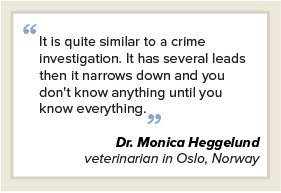
Monica Heggelund

Evidensia Oslo Animal Hospital photo
Dr. Monica Heggelund, a specialist in small animal medicine at Evidensia Oslo Animal Hospital, said the hospital has been admitting as many as nine dogs with the mystery illness each day.
Authorities investigating dozens of sudden dog fatalities in Norway have ruled out algae poisoning and tick-borne disease as culprits, though a likely cause that could link the deaths has yet to be identified.
More than 20 dogs have died during the past week or so after presenting with bloody diarrhea and vomiting, according to updates posted by the Norwegian Veterinary Institute and Norwegian Food Safety Authority. An infectious disease outbreak is being considered as a possible cause of the illnesses.
Symptomatic dogs have been reported in 14 of Norway's 18 counties, but most cases are in Oslo.
Dr. Monica Heggelund, a veterinarian working at the Evidensia Oslo Animal Hospital, told the VIN News Service that she and her colleagues have been seeing up to nine suspected cases per day. Symptoms suffered by the dogs are severe, she said, and include hypovolemic shock, tachycardia and hypothermia.
"They have been really ill," Heggelund said via telephone. "We're seeing bloody water pouring out of the back end, so really dramatic signs and quite a dramatic illness."
Heggelund, a specialist in small animal medicine and Evidensia's medical director for Norway, said some sick dogs have stayed at the practice for days, and a dozen patients spent the night at the practice on Monday.
There have been no deaths at her hospital, though she has been told of fatalities at nearby clinics in central Oslo.
Jorun Jarp, the emergency and safety director of the Veterinary Institute, told national broadcaster NRK on Saturday that 21 dogs had died rapidly after suffering severe intestinal symptoms. Additional deaths have been mentioned in subsequent updates from the Norwegian Veterinary Institute and Norwegian Food Safety Authority. Neither organization responded to VIN News' requests for comment.
Elsewhere in the country, Dr. Anne Line Meltzer, a veterinarian at the AniCura Drammen Animal Clinic about 25 miles west of Oslo, said she's encountered an unusually high number of severe enteritis cases.
 Two dogs presenting over the weekend with acute vomiting and bloody diarrhea had to be sent from her clinic to Oslo for hospital treatment. Another dog died at her clinic on Sunday morning, while a fourth case reported by an owner on the phone was sent straight to Oslo without visiting her clinic first.
Two dogs presenting over the weekend with acute vomiting and bloody diarrhea had to be sent from her clinic to Oslo for hospital treatment. Another dog died at her clinic on Sunday morning, while a fourth case reported by an owner on the phone was sent straight to Oslo without visiting her clinic first.
Meltzer said the dog that died on Sunday presented a particularly uncertain case, because it already had received treatment on Friday and could have reacted adversely to the medication.
She has also noticed a "slight" rise in cases displaying milder symptoms. "We have a lot of owners that are calling and coming in, but on the other hand, there are also owners that don't want to come in for routine checks because they are afraid of contamination," she said via telephone.
"And you don't see many dogs on the street anymore. I think most people are just taking them out in their gardens."
The strongest lead from investigations conducted by authorities so far has been the discovery of a single type of bacterium, Providencia alcalifaciens, in most dead dogs presented for autopsy.
Two autopsies conducted on Monday at the Veterinary Institute in Oslo found notably large quantities of P. alcalifaciens, according to the most recent update posted by the institute on Wednesday. The bacterium has now been found in nine dogs from eight autopsies and one stool sample taken from a live animal.
Another bacterium found in earlier autopsies, Clostridum perfringens, was not found in the autopsies conducted on Sunday and Monday. Both P. alcalifaciens and C. perfringens can trigger diarrhea, though they can also be found in healthy dogs.
Dr. Scott Weese, a professor at the Ontario Veterinary College at the University of Guelph and an expert on microbial infections, suggested that although P. alcalifaciens could be responsible for the deaths, it may well not be.
"I have my doubts," Weese told VIN News, noting that P. alcalifaciens levels can spike in individuals suffering from some other type of disease.
"It can’t be ruled out, but based on what we know about this bug in other species, I would be hard pressed to call it the cause," he said via email.
No signs of Salmonella or Campylobacter infection have been discovered, nor has there been evidence of rat-poison ingestion, according to the Veterinary Institute. In an update on Tuesday, the institute said the deaths also were unlikely to be the result of algae poisoning, tick-borne diseases, anthrax or plague.
The organization has advised dog owners to be wary of social media posts linking the illness to certain types of pet food. "On the contrary, we see a wide range of feed products in the material we have to date, which underscores the complexity of the case," it said.
Evidensia's Heggelund said she suspects environmental factors could be at play, though she stressed that was just her guess.
It is not unusual, Heggelund said, to see enteritis cases in dogs during the Norwegian spring and fall when it is humid outside, with lots of rain or melting snow that can harbor various pathogens. The weather had been especially humid in and around Oslo over the past month or so, corresponding to a peak in enteritis cases, she said.
"My gut feeling is that this disease is not very contagious between dogs," Heggelund added, noting that most cases she is aware of have involved a single dog, even in households with two or more dogs. There also have been few signs of infections passed among dogs in veterinary clinics — an observation corroborated by Meltzer — or reports of infection between dogs attending competitions and exhibitions.
To be sure, Heggelund noted that the number of patients suffering from enteritis symptoms this year has been much higher, and the clinical signs more severe. Heggelund's hospital, for instance, admitted twice as many dogs this August with enteritis symptoms than last August. Generally, old and very weak dogs are more typically sickened. However, healthier and bigger dogs were being admitted this time, further justifying the current national probe.
"It is quite similar to a crime investigation," Heggelund said. "It has several leads then it narrows down and you don't know anything until you know everything."
The Veterinary Institute sent on Sunday a questionnaire to 2,000 Norwegian veterinarians in an attempt to collect information on all suspected cases and symptoms seen by practitioners since Aug. 1. Investigators intend to use the results to gain a better understanding of the illnesses and cause of the deaths.
Individuals with sick or dead dogs have been advised to keep samples of what their dog had eaten for the past 14 days to assist with investigations.
"We maintain our advice to dog owners to limit close contact between dogs and to keep dogs on leashes so that they are controlled,” a statement from the Food Safety Authority said. Dogs should be prevented from sniffing areas where other dogs have been, it added.
The Norwegian Kennel Club has canceled all dog shows while the investigation is under way and plans to assess the situation as it evolves. Dogs from Norway are banned temporarily from shows in Sweden and Denmark, according to the Associated Press.
This story has been changed to remove a hotlink to a resource that is no longer available.